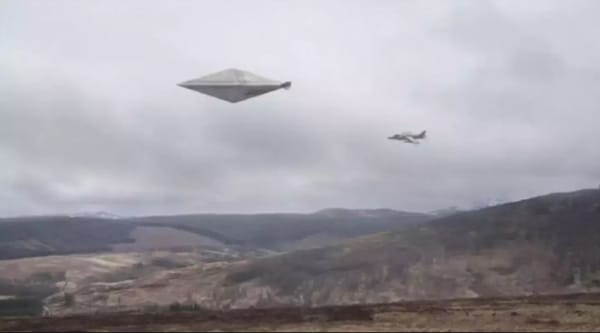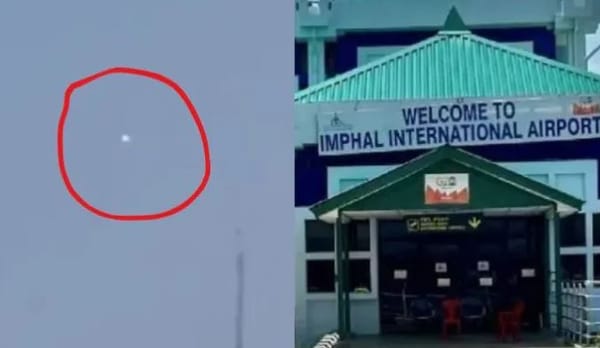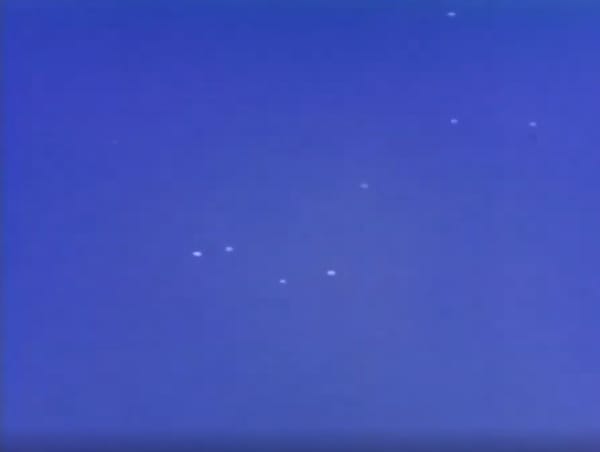The 1951 Lubbock Lights

In the late summer of 1951, residents of Lubbock, Texas, reported a series of intriguing aerial phenomena, collectively referred to as the "Lubbock Lights." Over the course of August and September, multiple observers, including Texas Tech University professors and local citizens, reported seeing formations of bright lights moving across the night sky. The incident garnered significant national attention and prompted an investigation by the U.S. Air Force under Project Blue Book.
The initial sighting occurred on August 25, 1951, when three Texas Tech professors observed a cluster of lights traversing the sky. The phenomenon was later documented through photographs taken by Carl Hart, Jr., a Texas Tech student, which depicted a "v" formation of lights. The U.S. Air Force investigated the sightings and, despite various theories, including the possibility of migratory birds reflecting street lights, could not definitively explain the nature of the lights. The Lubbock Lights remain a notable event in the study of unidentified aerial phenomena, contributing to ongoing discussions about the nature of such sightings and the methods of investigation used to understand them.
The Incident
The reports originated from multiple credible witnesses, including Texas Tech University professors and local residents, and were marked by consistent descriptions of bright lights moving in specific patterns across the night sky.
Initial Sighting
The first notable sighting occurred on the evening of August 25, 1951. Three professors from Texas Tech University—A.G. Oberg, W.L. Ducker, and W.I. Robinson—were socializing in the backyard of one of their homes when they observed a formation of 20 to 30 lights flying overhead. The lights, described as being as bright as stars but larger, were noted for their distinctive movement and brightness. The professors ruled out meteors or other common explanations as the lights appeared to be too slow and structured in their flight pattern. As the professors continued to watch, a second group of similar lights passed overhead, reinforcing the unusual nature of the sighting.
The observations were reported to the local newspaper, the Lubbock Avalanche-Journal. In addition to the professors' accounts, several other witnesses, including three local women, reported seeing similar lights on the same night.
Subsequent Observations
A second significant sighting occurred on September 5, 1951. On this date, the original trio of professors, joined by two additional colleagues from Texas Tech University, observed another group of lights in the night sky. The lights were described as being greenish-blue and fluorescent, and the witnesses noted that they appeared in a formation that was circular and different from their earlier sighting. The lights were observed moving at high speed, estimated to be over 600 miles per hour, and were seen above a thin cloud layer at approximately 2,000 feet. The professors expressed uncertainty about the lights’ nature, noting that the speed and behavior of the lights did not match that of known aircraft or natural phenomena.
Photographic Evidence
On August 30, 1951, Carl Hart, Jr., a freshman at Texas Tech, observed a formation of 18 to 20 white lights flying in a "v" formation. Hart used a 35-mm Kodak camera to capture the lights and managed to take five photographs before the lights disappeared. Upon developing the photos, Hart presented them to the Lubbock Avalanche-Journal. The newspaper's editor, Jay Harris, purchased the photos and published them, leading to their widespread dissemination. The photographs showed a series of lights in formation and were featured in various newspapers and magazines, including Life magazine.
The photos were analyzed by the physics laboratory at Wright-Patterson Air Force Base. Edward J. Ruppelt, the head of Project Blue Book, later commented that while the photos were not definitively proven to be a hoax, their authenticity could not be fully verified. The professors who had originally observed the lights noted that the photos did not match their descriptions, particularly regarding the formation of the lights.

Air Force Investigation
In late September 1951, the U.S. Air Force, through its Project Blue Book program, began investigating the Lubbock Lights. Edward J. Ruppelt, who led the investigation, interviewed the professors, Carl Hart, and other witnesses. Ruppelt's initial conclusion was that the lights might have been reflections from migrating plovers, a type of bird known for flying in formations. This theory was supported by observations of birds flying over street lights, which reflected similar lighting patterns. However, some witnesses, including local farmers and biologists, disputed this explanation, arguing that the speed and size of the lights did not correspond with the behavior of plovers.
Ruppelt also noted additional reports of a "flying wing" seen by various individuals in the Lubbock area, which might have contributed to some of the sightings. However, the exact cause of the lights remained undetermined, with the Air Force's investigation unable to conclusively explain the phenomenon despite extensive efforts.
The Lubbock Lights incident remains a notable example of unexplained aerial phenomena, reflecting the challenges of interpreting and investigating such events with the available methods and knowledge of the time.
Aftermath
Following the investigation into the Lubbock Lights, the incident continued to generate interest and debate within both the scientific community and the public. The aftermath of the Lubbock Lights case involves ongoing discussions about its significance, the media coverage it received, and its impact on UFO studies and popular culture.
Public and Media Reaction
The Lubbock Lights incident quickly captured the attention of the media, with reports appearing in newspapers across the United States. Notably, the photographs taken by Carl Hart, Jr. were featured in Life magazine, contributing to widespread national interest. The images, alongside the testimonies of credible witnesses, helped maintain public curiosity about the nature of the lights.
In April 1952, Life magazine published an article on the UFO phenomenon, prominently featuring the Lubbock Lights. This article helped solidify the incident’s place in the broader context of UFO reports and contributed to the growing public fascination with unidentified flying objects.
Air Force and Scientific Community
The U.S. Air Force’s Project Blue Book, which investigated the Lubbock Lights, concluded that the sightings were most likely due to reflections of street lights from birds in flight, specifically plovers. This explanation, while not universally accepted, was supported by some witnesses and appeared to address the majority of the observed phenomena.
Despite the Air Force's conclusions, several scientists and experts remained skeptical of the plover theory. The nature of the lights, their speed, and their apparent patterns led some to question whether other explanations might be more plausible. The case became a subject of study in the field of UFO research, highlighting the difficulties in resolving such phenomena with the scientific tools and methods available at the time.
Cultural Impact
The Lubbock Lights left a lasting mark on popular culture and UFO lore. The incident was featured in various media and entertainment formats. In 1999, Dallas television station KDFW aired a news story revisiting the case, interviewing Carl Hart, Jr., and discussing the photographs and investigations. The Lubbock Lights were also depicted in the 2002 Sci Fi Channel miniseries Taken, which dramatized the incident within a fictional narrative of alien encounters.
In 2005, a film titled Lubbock Lights was released, exploring the music scene in Lubbock while referencing the lights and their significance. Additionally, in 2006, the alternative country band Thrift Store Cowboys released a song titled "Lubbock Lights," reflecting the incident’s influence on local and cultural expression.
The 2019 History Channel television series Project Blue Book included an episode titled "The Lubbock Lights," dramatizing the investigation and contributing to the ongoing interest in the case. The portrayal of the incident in various media underscores its continued relevance and intrigue as a notable event in the study of unexplained aerial phenomena.
Legacy
The Lubbock Lights incident remains a significant event in the history of UFO sightings, illustrating the challenges of investigating and understanding unexplained phenomena. It has become a case study in both UFO research and public reaction to aerial mysteries, reflecting broader themes in the search for answers to unusual and enigmatic occurrences.
Possible Explanations
The Lubbock Lights have been attributed to several possible explanations, each attempting to address the unusual sightings reported in 1951:
Migratory Birds
A prominent theory suggested by the U.S. Air Force’s Project Blue Book is that the lights were reflections of street lights off migrating plovers. According to this explanation, the birds flying in formation at night could have reflected the light from newly installed vapor street lights, creating the appearance of bright, moving objects in the sky. Witnesses who saw similar reflections from birds illuminated by street lights supported this theory.
Aircraft
Another explanation considered was that the lights could have been caused by conventional or experimental aircraft. Some reports mentioned a “flying wing,” possibly indicating the presence of military or experimental planes. However, this theory struggled to fully account for the specific formations and speeds observed.
Atmospheric and Optical Effects
Some researchers proposed that the lights might have been caused by unusual atmospheric or optical effects. These could include reflections, refractions, or distortions created by a combination of weather conditions and artificial lighting. Such effects might create the illusion of bright, moving lights in the sky.
Extraterrestrial Vehicles
The idea that the lights could have been extraterrestrial vehicles was also considered, particularly given the broader context of UFO phenomena at the time. The unusual nature of the sightings, including the described formations and speeds, led some to speculate about the possibility of alien spacecraft. While this theory captured public imagination, it lacked concrete evidence and was not supported by the Air Force’s investigation.
Hoaxes
Although not widely supported by evidence, the possibility of hoaxes was also considered. The theory posits that the photographs or reports might have been fabricated or exaggerated. However, the consistency of the sightings among multiple credible witnesses makes this explanation less likely.
Despite these varied explanations, the true nature of the Lubbock Lights remains unresolved, leaving room for continued debate and curiosity about the origins of the phenomenon.
Another explanation considered was the possibility of conventional aircraft, including experimental or military planes, contributing to the sightings. The reports of a "flying wing" observed by some witnesses may suggest that certain aircraft, possibly flying at night, could have been mistaken for the lights seen. However, this theory struggled to account for the precise movements and formations described by witnesses.
Atmospheric and Optical Effects
Some researchers proposed that the lights might have been caused by unusual atmospheric or optical effects. These could include reflections, refractions, or distortions created by the combination of weather conditions and artificial lighting. Such effects could potentially create the illusion of bright, moving lights in the sky.
Hoaxes
Although not widely supported by evidence, the possibility of hoaxes was also considered. The idea is that the photographs or reports could have been fabricated or exaggerated. However, the consistency of the sightings among multiple credible witnesses makes this theory less likely.
Despite these explanations, the exact nature of the Lubbock Lights remains uncertain, as no single theory has been able to comprehensively account for all aspects of the sightings.
Conclusion
The Lubbock Lights remain a compelling and enigmatic chapter in the history of unexplained aerial phenomena. Despite extensive investigation and various proposed explanations, including reflections from migratory birds and possible aircraft sightings, the true nature of the lights observed over Lubbock, Texas, in 1951 remains unresolved. The incident's lasting impact on public interest and its portrayal in media underscore its significance in the study of unidentified aerial phenomena. As a notable case in UFO research, the Lubbock Lights continue to inspire curiosity and debate about the boundaries of scientific explanation and the mysteries of the night sky.



